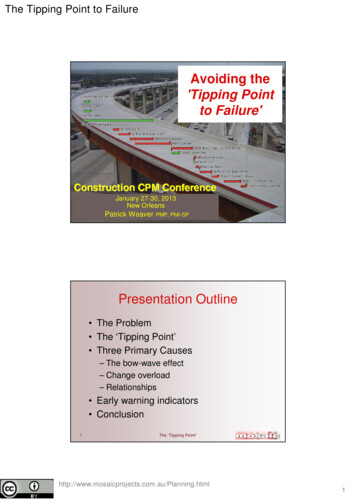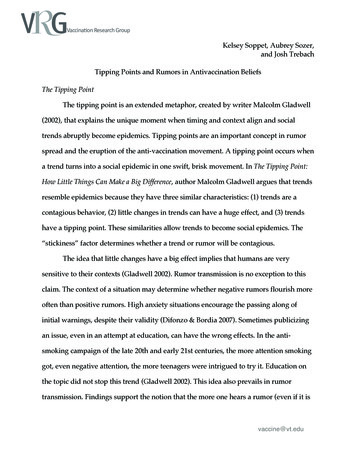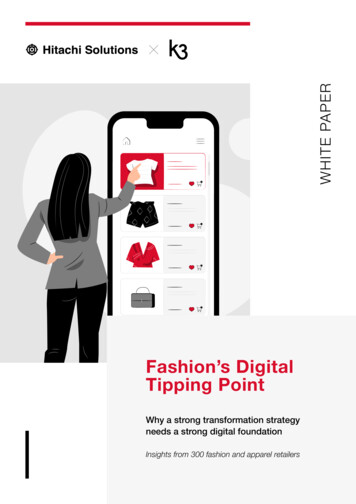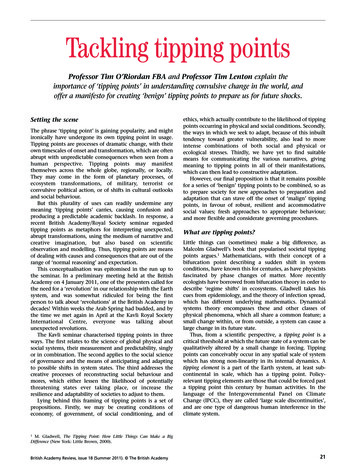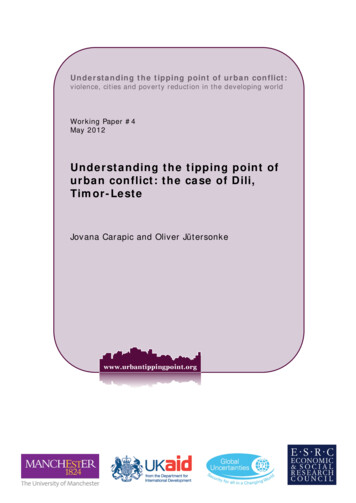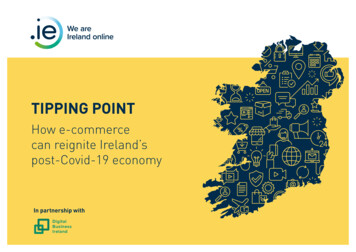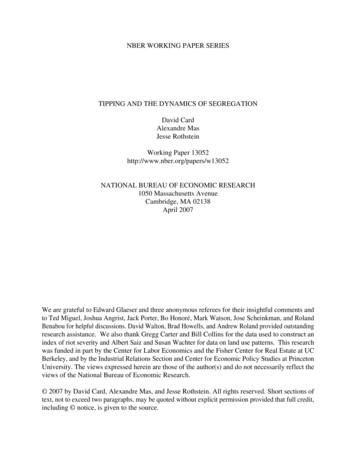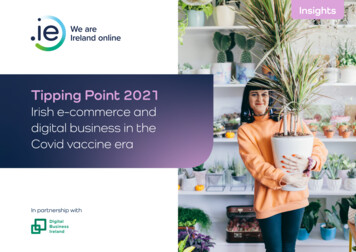
Transcription
InsightsTipping Point 2021Irish e-commerce anddigital business in theCovid vaccine eraIn partnership withDigitalBusinessIrelandDigitalBusinessIreland
ForewordWhile vaccines offer Ireland a way out of lockdown, until a criticalmass is reached and the population is immunised, our economy andsociety are set to remain in a state of flux.This flux is accelerating major trends in e-commerce and digitalisation.Behaviours and ways of working that boost sales, cut costs or increaseconvenience are likely to become permanently ingrained.Few consumers are fully comfortable at the thought of shopping on theirlocal high street and the majority expect either the same or more pandemicrestrictions in 2021. Most anticipate shopping for most or all products onlinethis year.In the previous edition of this report, consumers said they had done themajority of their online shopping with Irish SMEs since the beginning of theCovid crisis, not with international retailers. However, it appeared that muchof this ‘buy local’ sentiment was rooted in crisis solidarity with Irish businesses.At the time, the report indicated that as the economy emerged from lockdown,Irish SMEs could once again lose out to international retailers if they failedto recognise and hone their competitive advantages, such as trust andreliability, or level the playing field with a better online storefront or website.The 2021 .IE Tipping Point report shows that this reversal has alreadyoccurred, despite the economy being more locked down than before.While Irish consumers are still eager to support local businesses throughthe pandemic, other factors, particularly price and range, have returnedto prominence. Irish SMEs need to focus on their USPs and invest theirresources in improvements to online customer experience and service,which consumers explicitly value.Despite being overtaken again, Irish SMEs in certain sectors still have plentyto cheer about. Sustained online spending and Government supports meanthe majority are positive about their financial outlook for 2021. Those thathave invested in their website or online store have reaped the rewards: mostsay they are busier than or as busy as they were before the pandemic.There is also growing evidence of an understanding of Irish consumer needs.There has been a remarkable shift in the number of SMEs that have investedin their online presence, and a growing cohort of business owners see thefuture of retail in e-commerce.ContentsPrior to the coronavirus pandemic, digital advocates struggled to getlarge scale buy-in to an online proposition that was developing, albeitmuch more slowly than current trends demonstrate.However, the fluidity of the business landscape and the sharp escalationin the migration to online, amid three lockdowns, has led to businessowners fundamentally re-thinking their operations. Last March, manybelieved the situation was temporary but with reports of continuingpublic health measures, longer term planning and investment in onlinehave become more urgent.While there is a more enhanced understanding of the nature andimpact of the virus from a medical point of view, it remains challengingfor businesses who are struggling to keep up with changing consumertrends. This is precisely why research of this quality is essential forbusiness leaders, who need to better understand the behaviours andthinking of their target audiences.The outputs from this robust research will help e-commerce professionalsto keep ahead of the curve and better understand the factors thatconvince their customers to purchase from them. A degree of slippagein support for home grown indigenous businesses has all the hallmarksof features of pre-pandemic shopping, when online customers weremotivated by price, range and customer experience. Stemming this tidewill be key to enabling a robust digital eco-system for online businessesto grow and thrive.The fundamentals remain strong though, with twice as many SMEsinvesting in their online offering. However, a focus on enhancing trust,ensuring reliability and a positive customer experience must be coreelements of the 2021 digital journey.On a positive note, a vast majority of online businesses have reportedthat they are as busy as, if not busier than before the pandemic. Whileencouraging, it is important that this does not become a trade off withthe high street, which faces challenges such as negative consumerconfidence trends, town centre decay and lack of retail diversity.This report shows that the pandemic is acting as a digital accelerant. Localand national decision-makers planning Ireland’s post-Covid recovery musttake this into account.Unquestionably, the future of business is omni-channel, with aphysical and digital footprint. It is important to stress that conceptsare not mutually exclusive; what’s bad for one permeates the other.Therefore, adequate policy responses are needed to ensure a robustshopping landscape where online and bricks-and-mortar coalesceand co-exist together.David CurtinChief Executive, .IELorraine HigginsSecretary General, Digital Business Ireland1Key findings2Insights3Section 1The vaccine era, butno return to normal4Section 2The Covid consumer7Section 3The Covid SME10Methodology
Key findingsThe 2021 .IE Tipping Point report survey, carried out in January, assessed theattitudes and responses to the Covid-19 pandemic of 1,000 Irish consumersand 500 retail and consumer-facing professional services SMEs.For some questions, respondents were asked to compare their currentsituation or opinion to 2019, pre-Covid, and to anticipate their futurebehaviour post-Covid. To record shifts in behaviours and attitudes in thelast six months, 2021 data is compared, where relevant, with data fromthe 2020 report survey, which was carried out in June and July 2020.These eight key findings provide an overview of some of the most importantCovid ‘vaccine era’ trends in Irish SME e-commerce, digitalisation andconsumer behaviour.CONSUMER FINDINGS 55% of consumers believe that life in 2021 will be more or less thesame as life in 2020, or even more restricted. Few think that life willreturn to normal this year. Despite a surge of patriotism in the initial six months of the pandemic,the majority of online shoppers have swung back from Irish SMEs tointernational retailers. In 2021, 49% said they have mostly purchasedfrom Irish SMEs since the Covid crisis compared to 53% in 2020. Consumers view international retailers as more competitive on price,range and online experience, but they view Irish SMEs as more reliableand trustworthy. Irish SMEs should focus their digital investment inthese areas of competitive advantage. Only 23% of consumers currently feel fully comfortable shopping inphysical stores on their high street. Most would prefer to wait untilrestrictions are lifted or vaccines are more generally available.SME FINDINGS The number of SMEs that have invested in their online presencehas increased massively, from 21% in 2020 to 55% in 2021.The majority recognise that the future of their business dependson adding some kind of digital offering. 30% of SMEs sell a physical product via an online store, up from 25%in 2020. Of these, the vast majority—almost 9 in 10—have noticedan increase in their sales numbers since the Covid crisis began. 78% of SMEs that have invested in their online services say they arebusier than or as busy as before the Covid crisis, up from 46% in 2020.SMEs opinions on consumer purchasing habits are changing; morebelieve that consumers will do the majority of their shopping online. 61% of SMEs said online services will be more important to theirbusiness in 2021 than they were in 2020. A greater number of SMEsnow accept that their business model is likely to be permanentlychanged by the pandemic.IE Tipping Point 2021: Irish e-commerce and digital business in the Covid vaccine era 1
InsightsHERE AND NOWLocal and global factors that are currently influencing consumer behaviour and Irish e-commerce.1. ‘Buying Irish’ isn’t enough2. Play to your strengths3. Brexit: advantage Ireland?In this edition of the .IE Tipping Point report,more consumers who reported doing themajority of their online shopping with IrishSMEs said they did so out of a desire tohelp local businesses through the pandemic. However,overall online spend has actually swung away fromIreland and back to international retailers.Multinationals with globalised supply chainshave many clear advantages over IrishSMEs. They can be far more competitive onprice and range. In these respects they canbe unassailable, and SMEs trying to undercut them ina race to the bottom are wasting their scarce time andmoney and potentially endangering their business.While Irish SMEs no doubt prefer that Brexithad not happened, the UK’s withdrawalfrom the EU may actually confer localbusinesses with some advantages. SMEsshould seek to exploit them and inform their customerswherever possible.Crisis solidarity is not enough for a stable e-commercestrategy. Irish SMEs seeking to sustain their businessthrough their online store can only retain theircustomers in the long term by consistently improvingthe online customer experience.However, SMEs still have competitive USPs, such astrust and reliability. They need to focus on perfectingthese advantages—for example, with personalisedcustomer communications or faster delivery services—so that shopping local continuously generates benefitsand value-adds for their customers.For example, because many Irish SMEs ship goodsentirely within Ireland, they can pass on cost benefitsto consumers, who will not have to pay unforeseencustoms charges. Delivery from within Ireland is alsofaster, as customers do not experience the recentdelays associated with border inspections andcustoms checks on goods.FUTURE TRENDSShort- and medium-term trends with the potential to shape the future of digital Ireland.4. Omni-channel is preferred5. Virtual service delivery6. No way backConsumers are spending more online andintend to keep doing so after the pandemic.Their in-store shopping routines havechanged over the last year, and many nowfavour visiting shops at a certain time of the week,when they view them as safer or less crowded.While Irish SMEs and international retailersremain locked in a constant struggle to winmarket share of online spend on physicalproducts, this report shows that Irish onlineservice providers have a clear advantage over theiroverseas counterparts.The pandemic is a continuum, not astandalone event. Shifts in consumerand SME behaviour are still occurring,some now at a faster rate, others slower.From a digital perspective, it is clear that thepandemic is having an accelerant effect.This may help to accelerate a long-observed trend thatsuggests consumers now prefer to buy necessitiesonline during the week—the ‘midweek convenience’—and save discretionary purchases for the weekend‘experience’. If this behaviour becomes more apparent,bricks-and-mortar SMEs that have invested in an onlinestore since lockdown will have a major advantage overtheir offline competitors after the pandemic.However, services are still purchased only infrequentlyonline by consumers. This may be because many IrishSMEs and professional services firms have not yetinvested in the tools or methods required to make theconsumer experience useful and seamless. Serviceproviders should therefore begin by undertaking aninternal assessment of their use and deployment oftechnology, and whether it is fit for purpose.What we view as Ireland’s digitalisation tippingpoint may, therefore, be an accelerating downwardspiral for those who fail to adapt as e-commerceand online interaction become the default. Localauthorities and national decision-makers mustconsider these factors if their digital developmentplans are to be effective and relevant.IE Tipping Point 2021: Irish e-commerce and digital business in the Covid vaccine era 2
Section 1The vaccine era, but noreturn to normalWhile Irish consumers are fairly evenly divided on thecountry’s prospects of a return to normal in 2021,most still don’t feel comfortable shopping in-storeon their local high street.The pandemic remains an ongoing crisis. While vaccineshave laid down a path back to normality, all governmentand medical advice suggests that economic restrictionsand social distancing requirements are likely to remain inplace until at least the end of 2021.Consumers seem to be mostly on the same page. 37%believe that life in 2021 will be more or less the same as itwas in 2020, while 18% believe that life will be even morerestricted despite the vaccine rollout.Only 10% believe that all pandemic restrictions will be liftedby the end of the year. Just over a third (35%) believe thatwe will approach pre-Covid normality in 2021, but somerestrictions will still be in place at the end of the year.Our research data provides a rough timeline of whenconsumers expect to feel comfortable shopping in-store.At present, fewer than a quarter of consumers (23%) areentirely at ease shopping in-store on their local high street.With the majority of consumers having reservations aboutshopping in-store, an online channel is crucial for SMEs inorder to survive the restrictions imposed by the pandemic.For businesses and government decision-makers, it is clearthat many of the new or accelerated trends in consumerbehaviours seen in 2020 will continue this year. Many, in fact,may now be permanent.When do you think you will feel comfortable shoppingin physical stores on your local high street?When the government declares thatsocial distancing and masking areno longer necessaryI already feel comfortable shopping inphysical stores on my local high streetBase: 1,000, all consumers6%16%23%I will not feel comfortable shoppingin physical stores ever again28%27%45%believe that life will returneither mostly or completelyto pre-Covid normality bythe end of 202155%believe that life in 2021 willbe mostly the same as life in2020 or even more restrictedBase: 1,000, all consumersWhen cases of Covid are muchlower than they are nowWhen vaccination is available to thegeneral population, not just at-risk groups.IE Tipping Point 2021: Irish e-commerce and digital business in the Covid vaccine era 3
Section 2The Covid consumerThe way Irish consumers spend online andin-store are changing. The speed of this changemay be difficult for Irish SMEs to adapt to unlessthey focus on their competitive advantages overinternational retailers.Despite the pandemic and its restrictions, overall consumer spendinghas held up, decreasing in some areas but increasing elsewhere, suchas online retail.The 2021 .IE Tipping Point report shows that 27% said they were betteroff and under a third (31%) were worse off. 43% of consumers reportedlittle or no difference to 2019.The overwhelming majority (94%) said they had made an online purchasein 2020, while 68% said they spent more online in 2020 than they did in2019. In the previous survey, only 49% said they had spent more since thebeginning of the Covid crisis.46% of younger Millennials said they spent “significantly more” online in2020 than 2019 compared to the 36% population average.Consumer spending with Irish and internationalbusinesses since the pandemic beganIrishInternational49%51%47%12%28%7%Have shopped mostly onweekdays in the AMhave shopped mostly onweekdays in the PMhave shopped mostly onweekends in the AMhave shopped mostly onweekends in the PMBase: 710, consumers who say the time at which theyshop in-store has changed since the pandemic53%2021Change of routine202047%.IE Tipping Point 2021: Irish e-commerce and digital business in the Covid vaccine era 4
The Covid consumer [continued]Behavioural changesA sizeable 42% say they will domost of their shopping in physical,bricks-and-mortar stores in 2021,despite the current restrictions,down from 48% in 2020. Greaternumbers say they will shop onlyfor necessities in-store but buymost other products online(43% vs 41%) or do most of theirshopping online (15% vs 11%).These changes reflect the currentstate of the pandemic. The longercompulsory online shoppingcontinues, the more entrenched itwill become in consumer behaviour.Among those who will do most oftheir shopping in physical stores thisyear, 61% say it is more convenientand 39% say they simply want togo outside or have some kind ofsocial interaction. Interestingly, thelatter figure has declined from 55%in 2020, again likely in response torising Covid cases and the severityof the continuing lockdown.However, even among those whoshop in physical stores, behaviourshave changed. 71% say thatthe time of day when they haveshopped has changed, with almosthalf saying that they have shoppedmostly on weekdays mornings.The prospect of socialising has theexact opposite effect on the 15%of consumers who will do mostof their shopping online: 66% sayonline shopping is safer and requiresless interaction. 52% say it is moreconvenient, while 46% say it savesthem time.Ireland vs the worldIn 2020, 53% of consumers saidthey had done most of their onlineshopping with Irish SMEs since thestart of the pandemic. That numberhas now dropped to 49%, with themajority now once again buyingfrom international retailers.While consumers are keen tosupport local businesses during thepandemic—this number has risenfrom 67% to 74% among majoritySME shoppers—internationalbusinesses continue to proveattractive. Cheaper prices, betterproduct ranges and superior onlinestorefronts were key factors drivingbehaviours among those that havedone most of their shopping withinternational businesses.Why consumers prefer to shop mostly in physical stores61%39%20%19%15%(62%, 2020)(55%, 2020)(14%, 2020)(24%, 2020)(21%, 2020)MoreconvenientWant socialinteraction/to go outsideCheaperSaves timePreferredretailers don’thave online storeBase: 418, consumers who will do most of their shopping in-store in 2021Why consumers prefer to shop mostly online66%52%46%42%30%(59%, 2020)(51%, 2020)(56%, 2020)(50%, 2020)(29%, 2020)Safer/less socialinteractionMoreconvenientSaves timeRequiresless travelCheaperBase: 153, consumers who will do most of their shopping online in 2021.IE Tipping Point 2021: Irish e-commerce and digital business in the Covid vaccine era 5
The Covid consumer [continued]However, consumer behaviour stillimplies competitive advantages forIrish SMEs. Solidarity and patriotismaside, many consumers think Irishbusinesses are faster and morereliable, more trustworthy (whichjumped to 48%, up from 41%)and have better order trackingand delivery.While consumers are most heavilyinfluenced by price, our survey findsthat reliability and speed are stillvalued, and it is here that Irish SMEscan focus their resources and gainadvantage. International retailersby no means have a monopolyon better storefronts or websites.With investment in a modern,e-commerce website, Irish SMEscan win over consumers who aresimply seeking a straightforwardand convenient online experience.Industries and servicesIn some product categories, IrishSMEs have a clear advantageover international businesses.Since the Covid crisis, consumershave been buying more furnitureand hardware, as well as toiletries,medicines and beauty products,from Irish businesses rather thanfrom international retailers.Where Irish SMEs are notoutright leaders, they are atleast competitive. Electronics andappliances have been bought fromIrish businesses and internationalretailers in equal proportions (43%)during the pandemic. 55% saythey have purchased clothes andshoes from international businessessince the pandemic, while 51%have purchased from Irish SMEs.Why consumers have shopped mostly withIrish businesses since the pandemicIrish SMEs that provide serviceshave a clear advantage overinternational businesses, butconsumer uptake remains relativelylow. 36% say they have purchaseda service from an Irish SME sincethe pandemic began, compared to24% from an international business.Cheaper19% have purchased a physicalhealth consultation from an IrishSME (vs 9% from an internationalbusiness) and 15% an onlineskills training class (vs 14% frominternational).While some services, particularlyhealth examinations, will likelybe better provided in person,consumers will respond well to SMEsthat fully utilise new technologiesto provide a seamless virtualexperience. This could includevideo conferencing, e-billing,e-prescriptions, or an instantmessaging service, particularly if itsaves them er order tracking/delivery service(67%, 2020)(48%, 2020)(41%, 2020)(30%, 2020)17%16%10%(11%, 2020)(13%, 2020)(11%, 2020)Want to supportthem during crisisFaster/more reliableBetter productrange31%Better websites/online storefrontsBase: 362, consumers who shopped mostly with Irish businessesWhy consumers have shopped mostly withinternational businesses since the pandemic72%67%35%(71%, 2020)(69%, 2020)(34%, 2020)23%26%9%(25%, 2020)(24%, 2020)(12%, 2020)CheaperBetter productrangeBetter order tracking/delivery serviceFaster/more reliableBetter websites/online storefrontsMoretrustworthyBase: 423, consumers who shopped mostly with international businesses.IE Tipping Point 2021: Irish e-commerce and digital business in the Covid vaccine era 6
Section 3The Covid SMEThe data is clear: SMEs that invest in awebsite and e-commerce reap the rewards.Those that have put money and time intodigital have generally fared better thanthose that have not.While the pandemic has thrown up all manner of challengesfor Ireland’s SMEs, the majority are optimistic about theircommercial outlook for 2021. 70% are either quite or verypositive; only 5% are explicitly negative.Those with a website are more likely to have a very positiveoutlook. Encouragingly, the number of SMEs with a websitehas increased to 75%, up from 66% in 2020. Those businessessay that their website has been important in generatingawareness (85%) and generating sales growth (72%).In further good news, 30% of SMEs now claim to selltheir products via an online store, up from 25% in 2020.However, just 17% sell a service online.An increasing proportion of businesses recognise that adigital channel is key to their survival while the pandemiccontinues. Consumers are spending more online, andSMEs with an online store have benefited. 86% say theyhave experienced an increase in sales or sales enquiriesfrom their online store since the pandemic began.This increase in website usage corresponds with the latest.ie domain registration figures. There were 65,113 new .ieregistrations in 2020, the highest figure ever recorded.Have you noticed an increase in youronline sales since the pandemic?The same as before5%9%86%Base: 152, SMEs that sell online% increase in sales of those whosaid ‘Yes, an increase’No, a decreaseYes, an increase1-10%21% 21%More than 51%11-24%26% 32%25-50%Base: 131, SMEs that sell onlinethat noticed an increase in sales55%have invested in their onlinepresence since the start ofthe pandemic21% have spentup to 50019% have spent between 500 and 2,499Base: 157, SMEs that sell online.IE Tipping Point 2021: Irish e-commerce and digital business in the Covid vaccine era 7
The Covid SME [continued]53%Growing investmentThe bottleneckThe number of Irish SMEs thathave invested any sum of moneyin their online presence has grownremarkably: 55% have investedsince the beginning of thepandemic, up from just 21%in 2020.For a majority of online SMEs,maintaining a digital presence hasbeen a straightforward experience.However, a small number havefound it difficult. Some havestruggled to update their websitesand social media profiles, whileothers have found it difficultadvertising and marketing theironline services. Other issues havestemmed from the macro pandemicenvironment, such as difficultieswith remote working and Covidrestrictions.Almost half (48%) made themajority of their investment duringthe initial March–June 2020lockdown, while 20% invested fromOctober to December, during thesecond national lockdown and theChristmas ‘easing’ period.Most SMEs have focused onlaunching or improving their website(52%), investing in online advertisingor marketing (33%), and launchingor improving their online voucherservice (28%).Because of this investment, 78% ofSMEs say they have been able tosustain pre-Covid levels of businessor are busier than before, up from46% in the summer of 2020.Expectations were mixed amongthis struggling cohort: 44%anticipated that maintaining anonline presence or selling onlinewould be difficult, while 43% did not.Lack of time was by far the mostprominent obstacle (31%), followedby a lack of personal or internalexpertise (21%) and a lack ofequipment or other resources (19%).76%of SMEs believe that Irishconsumers prefer to spendwith Irish businessesHowever, 52% of Irishconsumers currentlydo the majority of theironline shopping withinternational retailersBase: 500, all SMEsSME opinions on consumer habits have changed54%9%37%(24%, 2020)(23%, 2020)(53%, 2020)Consumers will prefer tobuy more products onlineConsumers will preferto buy more productsin physical storesConsumers will buy someproducts online and somein physical storesBase: 500, all SMEs (Q: Which of these statements best describes what you think will happento consumer shopping habits in 2021?)have found maintaining an online presenceor selling online straightforwardBase: 381, SMEs with an online presence.IE Tipping Point 2021: Irish e-commerce and digital business in the Covid vaccine era 8
The Covid SME [continued]79%Others have been clearly affectedby the shift in the economic statusquo and have found it difficultto find their customers onlineor convince them to use theironline store.The pandemic has undoubtedlybeen a baptism of fire for manySMEs. Local authorities, businessgroups and national policymakersshould continue to help SMEs withdigital skills training where possibleby addressing knowledge andresource gaps.Future intentionsWith a significant majority of SMEsbenefiting from online investment,and considering the currenttrajectory of the pandemic, it isperhaps unsurprising that mostfully intend to continue investingin their online presence in 2021.61% believe that their onlinepresence will be more important totheir business this year than last.Less than a quarter intend to scaleback their online services.However, SMEs appear to beoverestimating their overall strengthrelative to international businesses.53% believe that Irish consumersprefer to shop online with Irishbusinesses rather than internationalretailers (20%), despite almost theopposite being true.of SMEs will continueto invest in their onlineservices in 2021Base: 500, all SMEsHowever, SMEs are generally nowmore cognisant of the effectsof the pandemic on consumerbehaviour: 54% believe thatconsumers will prefer to buyproducts online over the nextyear, up from 24% in 2020.Irish SMEs also recognise theirunique advantages relativeto international businesses.As consumers do, they seethemselves as more reliable,trustworthy and with betterdelivery services.To generate sustainable, near-termwins for Irish e-commerce, it isimportant that local businessaccelerators and governmentagencies focus on helping SMEsconsolidate these USPs.Positive results from online investment?28%50%13%9%0%(21%, 2020)(25%, 2020)(19%, 2020)(16%, 2020)(19%, 2020)Yes, busierthan beforepandemicYes, same levelof business asbefore pandemicYes, althoughstill strugglingNo differenceUnsureBase: 86, SMEs that have invested since Covid.IE Tipping Point 2021: Irish e-commerce and digital business in the Covid vaccine era 9
MethodologyThe .IE Tipping Point report was commissionedby .IE, in partnership with Digital Business Ireland,and carried out by Core Research.A total of 1,000 consumers aged 18 weresurveyed via online questionnaire. A total of500 SMEs in the retail and customer-facingprofessional services sectors were interviewedvia telephone.Research was carried out between 11th and27th January 2021.About .IE.IE is the national registry for .ie domain names and is thetrusted and progressive guardian of Ireland’s unique online.ie address. Our purpose is to enable and empower people,communities and businesses across Ireland to thrive online.uWe operate the domain name system (DNS) for the .ienamespace, facilitate an independent dispute resolutionservice, and operate a public WHOIS lookup service for.ie domains.uIn cooperation with our Registrars, technical partnersand stakeholders, we help advance Ireland’s internetecosystem. Good governance is evidenced in ourpolicy development process for the .ie namespace,which follows a bottom-up, consensus-driven approachthrough a multi-stakeholder Policy Advisory Committee.SME sample size breakdown COMPANY SIZE1-5 69%6-10 1511-15 6%16-20 3%21-30 5%31 4%BUSINESS TYPE75 uMedical59Retail 51Finance (Accountant/Insurance) 40Legal (Solicitor/Lawyer) 39Architect/Interior Design 37Engineering/Manufacturing 29Garage/Car Repairs 17Construction (Plumber/Electrician/Carpenter) 17Auctioneer/Estate Agent 15Convenience Store/Newsagent 10Coffee Shop/Pub/Restaurant 9Beauty Salon/Hairdresser/Barber 6Horticulture 96OtheruAt .IE we are committed to digital advocacy for SMEs andfor local communities. Through stakeholder engagementinitiatives such as .IE Digital Town, we work with andsupport SMEs organisations to improve their members’online presence and e-commerce capabilities so theycan unlock the power of the internet to boost sales tolocal consumers.We also produce fact-based research for the businesscommunity and policymakers, such as the .IE DomainProfile Report and the .IE Digital Health Index, chartingthe attitudes to digital of Irish SMEs and consumers.There are over 315,000 .ie domain names registered. SinceMarch 2018, it is easier and faster to register a .ie domain.As part of the domain registration process, every applicantmust provide tangible evidence of a connection to Ireland.www.weare.ieAbout Digital Busine
.IE Tipping Point 2021: Irish e-commerce and digital business in the Covid vaccine era Key findings The 2021 .IE Tipping Point report survey, carried out in January, assessed the attitudes and responses to the Covid-19 pandemic of 1,000 Irish consumers and 500 retail and consumer-facing professional services SMEs.
